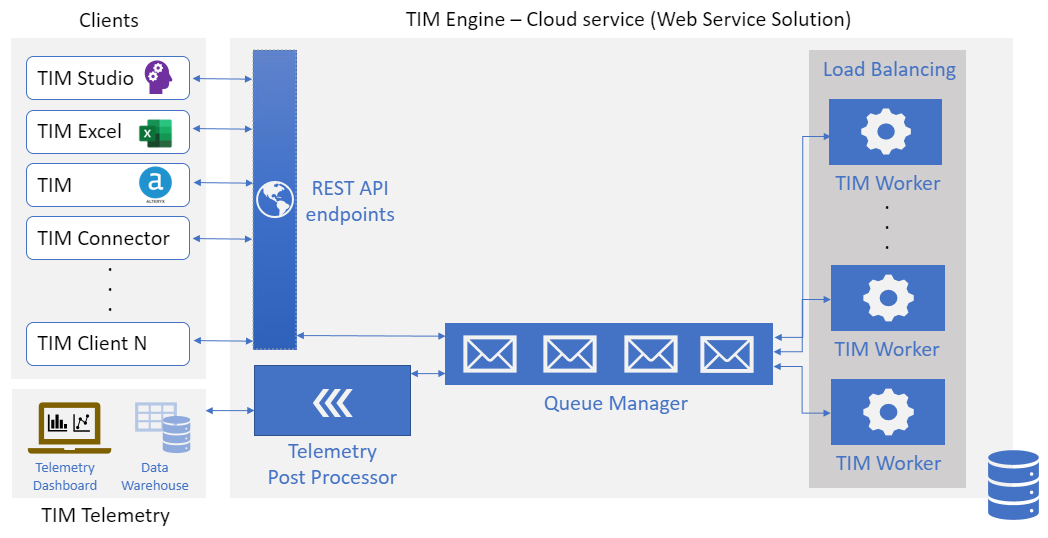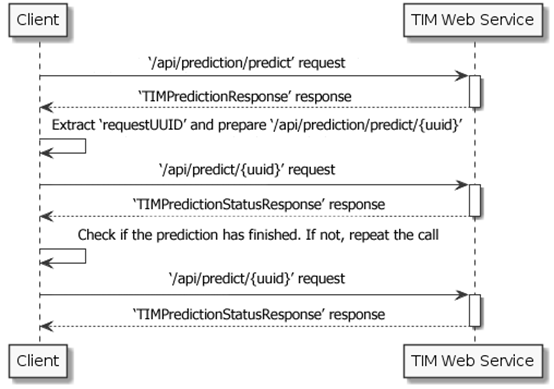Version 4
Overview
Tangent Information Modeler (TIM) is very mature and powerful forecasting and anomaly detection engine for a wide variety of different industries. See TIM overview to learn more.
The following subsections describe the architecture of TIM Web Service and all the existing forecasting and anomaly detection methods of the TIM API.
Web Service Architecture
TIM Web Service high level architecture is visualized below. A very important feature of this architecture is scalability. The highest computational complexity is distributed to the TIM Worker units. When computational demand increases, additional TIM Workers can be started, or are automatically started through the “Azure Container Instances” service.

Figure 1: TIM Web Service Architecture
API
UI version of TIM REST API, which allows visualization and interaction with the API’s resources (without the requirement to have the implementation logic in place) can be found at https://timws.tangent.works/v4/swagger-ui.html. If you'd like to open specific minor version, replace v4 with e.g. v4.0 in the above URL.
You can also get detail overview of TIM API at https://timws.tangent.works/v4/redoc.html. If you'd like to open specific minor version, replace v4 with e.g. v4.0 in the above URL.
Authentication
User accounts
In order to be able to call any of the available methods, a valid license and user account must be used.
Authentication methods
Basic authentication
Successful authentication requires the following:
- Configure the client to use Basic authentication with your username and password.
- Send your license key in HTTP header named
License-Key. - Send API key in HTTP header named
Api-Key.
Token authentication (since version 4.1)
Alternatively, you can use TIM License Manager to obtain a token and use it for authentication as following:
- Configure the client to use Bearer authentication with your token.
- Send API key in HTTP header named
Api-Key.
The client will be notified of authentication problems upon calling any method.
Methods Overview
TIM Web Service provides several asynchronous methods:
/prediction/build-model/prediction/predict/prediction/build-model-predict/detection/build-model/detection/rebuild-model/detection/detect
The status and the result of these methods can be retrieved with:
/prediction/build-model/{uuid}/prediction/predict/{uuid}/prediction/build-model-predict/{uuid}/detection/build-model/{uuid}/detection/rebuild-model/{uuid}/detection/detect/{uuid}
These status request methods are typically called on a regular basis. The “status” property in the responses contains information about the current status of the methods. When the current model building/forecasting/anomaly detection job successfully finishes, the value of the “status” property will be “Finished”.
The usual flow i.e. for prediction process is visualized in the picture bellow:

Figure 2: /prediction/predict method flow
Conventions
All requests and responses are in JSON format.
All timestamps shall be in UTC.
Date-time objects in requests / responses are represented with standard JSON “date-time” objects, which conform to ISO 8601 specification:
Example: "2010-10-01T00:00:00Z"
NaN (not a number) and Inf (infinity) values are not supported by TIM Web Service.
The maximum allowed size of the request/response is 100MB (UTF-8 length of JSON representation).